CONTENTS
FOREWORD
INTRODUCTION
1 Scope
2 Normative references
3 Terms and definitions
4 Symbols and abbreviated terms
4.1 Symbols and units
4.2 Abbreviated terms
5 Principal elements
5.1 General
5.2 Design methods
5.3 Safety classes
5.4 Quality assurance
5.5 Wind turbine markings
6 External conditions
6.1 General
6.2 Wind turbine classes
6.3 Wind conditions
6.3.1 General
6.3.2 Normal wind conditions
6.3.3 Extreme wind conditions
6.4 Other environmental conditions
6.4.1 General
6.4.2 Normal other environmental conditions
6.4.3 Extreme other environmental conditions
6.5 Electrical power network conditions
7 Structural design
7.1 General
7.2 Design methodology
7.3 Loads
7.3.1 General
7.3.2 Gravitational and inertial loads
7.3.3 Aerodynamic loads
7.3.4 Actuation loads
7.3.5 Other loads
7.4 Design situations and load cases
7.4.1 General
7.4.2 Power production (DLC 1.1 to 1.5)
7.4.3 Power production plus occurrence of fault or loss of electrical network connection (DLC 2.1 to 2.5)
7.4.4 Start-up (DLC 3.1 to 3.3)
7.4.5 Normal shutdown (DLC 4.1 to 4.2)
7.4.6 Emergency stop (DLC 5.1)
7.4.7 Parked (standstill or idling) (DLC 6.1 to 6.4)
7.4.8 Parked plus fault conditions (DLC 7.1)
7.4.9 Transport, assembly, maintenance and repair (DLC 8.1 and 8.2)
7.5 Load calculations
7.6 Ultimate limit state analysis
7.6.1 Method
7.6.2 Ultimate strength analysis
7.6.3 Fatigue failure
7.6.4 Stability
7.6.5 Critical deflection analysis
7.6.6 Special partial safety factors
8 Control system
8.1 General
8.2 Control functions
8.3 Protection functions
8.4 Control system failure analysis
8.4.1 General
8.4.2 Independence and common-cause failures
8.4.3 Fault exclusions
8.4.4 Failure mode return periods
8.4.5 Systematic failures
8.5 Manual operation
8.6 Emergency stop button function
8.7 Manual, automatic, and remote restart
8.8 Braking system
9 Mechanical systems
9.1 General
9.2 Errors of fitting
9.3 Hydraulic or pneumatic systems
9.4 Main gearbox
9.5 Yaw system
9.6 Pitch system
9.7 Protection function mechanical brakes
9.8 Rolling element bearings
9.8.1 General
9.8.2 Main shaft bearings
9.8.3 Generator bearings
9.8.4 Pitch and yaw bearings
10 Electrical system
10.1 General
10.2 General requirements for the electrical system
10.3 Internal environmental conditions
10.4 Protective devices
10.5 Disconnection from supply sources
10.6 Earth system
10.7 Lightning protection
10.8 Electrical cables
10.9 Self-excitation
10.10 Protection against lightning electromagnetic impulse
10.11 Power quality
10.12 Electromagnetic compatibility
10.13 Power electronic converter systems and equipment
10.14 Twist/drip loop
10.15 Slip rings
10.16 Vertical power transmission conductors and components
10.17 Motor drives and converters
10.18 Electrical machines
10.19 Power transformers
10.20 Low voltage switchgear and controlgear
10.21 High voltage switchgear
10.22 Hubs
11 Assessment of a wind turbine for site-specific conditions
11.1 General
11.2 Assessment of the topographical complexity of the site and its effect on turbulence
11.2.1 Assessment of the topographical complexity
11.2.2 Assessment of turbulence structure at the site
11.3 Wind conditions required for assessment
11.3.1 General
11.3.2 Wind condition parameters
11.3.3 Measurement setup
11.3.4 Data evaluation
11.4 Assessment of wake effects from neighbouring wind turbines
11.5 Assessment of other environmental conditions
11.6 Assessment of earthquake conditions
11.7 Assessment of electrical network conditions
11.8 Assessment of soil conditions
11.9 Assessment of structural integrity by reference to wind data
11.9.1 General
11.9.2 Assessment of the fatigue load suitability by reference to wind data
11.9.3 Assessment of the ultimate load suitability by reference to wind data
11.10 Assessment of structural integrity by load calculations with reference to site-specific conditions
12 Assembly, installation and erection
12.1 General
12.2 Planning
12.3 Installation conditions
12.4 Site access
12.5 Environmental conditions
12.6 Documentation
12.7 Receiving, handling and storage
12.8 Foundation/anchor systems
12.9 Assembly of wind turbine
12.10 Erection of wind turbine
12.11 Fasteners and attachments
12.12 Cranes, hoists and lifting equipment
13 Commissioning, operation and maintenance
13.1 General
13.2 Design requirements for safe operation, inspection and maintenance
13.3 Instructions concerning commissioning
13.3.1 General
13.3.2 Energization
13.3.3 Commissioning tests
13.3.4 Records
13.3.5 Post commissioning activities
13.4 Operator’s instruction manual
13.4.1 General
13.4.2 Instructions for operations and maintenance records
13.4.3 Instructions for unscheduled automatic shutdown
13.4.4 Instructions for diminished reliability
13.4.5 Work procedures plan
13.4.6 Emergency procedures plan
13.5 Maintenance manual
14 Cold climate
14.1 General
14.2 Low temperature and icing climate
14.3 External conditions for cold climate
14.3.1 General
14.3.2 Wind turbine class for cold climate
14.4 Structural design
14.5 Design situations and load cases
14.5.1 General
14.5.2 Load calculations
14.5.3 Selection of suitable materials
14.6 Control systems
14.7 Mechanical systems
14.8 Electrical systems
Annexes
Annex A (normative) Design parameters for external conditions
A.1 Design parameters for describing wind turbine class S
A.1.1 General
A.1.2 Machine parameters
A.1.3 Wind conditions
A.1.4 Electrical network conditions
A.1.5 Other environmental conditions (where taken into account)
A.2 Additional design parameters for describing cold climate wind turbine class S (CC-S)
Annex B (informative) Design load cases for special class S wind turbine designor site suitability assessment
B.1 General
B.2 Power production (DLC 1.1 to 1.9)
Annex C (informative) Turbulence models
C.1 General
C.2 Mann [3] uniform shear turbulence model
C.3 Kaimal [1] spectrum and exponential coherence model
C.4 Reference documents
Annex D (informative) Assessment of earthquake loading
D.1 General
D.2 Design response spectrum
D.3 Structure model
D.4 Seismic load evaluation
D.5 Additional load
D.6 Reference documents
Annex E (informative) Wake and wind farm turbulence
E.1 Added wake turbulence method
E.2 Dynamic wake meandering model
E.2.1 General
E.2.2 Wake deficit
E.2.3 Meandering
E.2.4 Wake induced turbulence
E.2.5 Wake superposition
E.2.6 Model synthesis
E.3 Reference documents
Annex F (informative) Prediction of wind distribution for wind turbine sites by measure-correlate-predict (MCP) methods
F.1 General
F.2 Measure-correlate-predict (MCP)
F.3 Application to annual mean wind speed and distribution
F.4 Application to extreme wind speed
F.5 Reference documents
Annex G (informative) Statistical extrapolation of loads for ultimate strength analysis
G.1 General
G.2 Data extraction for extrapolation
G.3 Load extrapolation methods
G.3.1 General
G.3.2 Global extremes
G.3.3 Local extremes
G.3.4 Long-term empirical distributions
G.4 Convergence criteria
G.4.1 General
G.4.2 Load fractile estimate
G.4.3 Confidence bounds
G.4.4 Confidence intervals based on bootstrapping
G.4.5 Confidence intervals based on the binomial distribution
G.5 Inverse first-order reliability method (IFORM)
G.6 Reference documents
Annex H (informative) Fatigue analysis using Miner’s rule with load extrapolation
H.1 Fatigue analysis
H.2 Reference documents
Annex I (informative) Contemporaneous loads
I.1 General
I.2 Scaling
I.3 Averaging
Annex J (informative) Prediction of the extreme wind speed of tropical cyclones by using Monte Carlo simulation method
J.1 General
J.2 Prediction of tropical cyclone induced extreme wind speeds
J.2.1 General
J.2.2 Evaluation of tropical cyclone parameters
J.2.3 Generation of synthetic tropical cyclones
J.2.4 Prediction of wind speeds in the tropical cyclone boundary
J.3 Prediction of extreme wind speed in mixed climate regions
J.3.1 General
J.3.2 Extreme wind distributions of extratropical cyclones by the MCP method
J.3.3 Extreme wind distributions of tropical cyclones by the MCS method
J.3.4 Determination of extreme wind speed in a mixed climate region
J.4 Reference documents
Annex K (informative) Calibration of structural material safety factors and structural design assisted by testing
K.1 Overview and field of application
K.2 Target reliability level
K.3 Safety formats
K.4 Reliability-based calibration
K.5 Calibration using the design value format
K.6 Partial safety factors for fatigue for welded details in steel structures
K.7 Types of tests for materials
K.8 Planning of tests
K.8.1 General
K.8.2 Objectives and scope
K.8.3 Prediction of test results
K.8.4 Specification of test specimen and sampling
K.8.5 Loading specifications
K.8.6 Testing arrangement
K.8.7 Measurements
K.8.8 Evaluation and reporting the test
K.9 General principles for statistical evaluations
K.10 Derivation of characteristic values
K.11 Statistical determination of characteristic value for a single property
K.12 Statistical determination of characteristic value for resistance models
K.12.1 General
K.12.2 Step 1: Develop a design model
K.12.3 Step 2: Compare experimental and theoretical values
K.12.4 Step 3: Estimate the mean value correction factor (bias) b
K.12.5 Step 4: Estimate the coefficient of variation of the errors
K.12.6 Step 5: Analyse compatibility
K.12.7 Step 6: Determine the coefficients of variation VXi of the basic variables
K.12.8 Step 7: Determine the characteristic value rk of the resistance
K.13 Reference documents
Annex L (informative) Cold climate: assessment and effects of icing climate
L.1 Assessment of icing climate conditions
L.1.1 General
L.1.2 Icing climate
L.1.3 Rotor icing
L.1.4 Measurement methods
L.1.5 Profile coefficients modification for ice
L.2 Ice mass effects on wind turbine blades
L.3 Cold climate design situations and load case
L.3.1 General
L.3.2 Power production (DLC 1.1 to 1.6)
L.3.3 Parked (standstill or idling) (DLC 6.1 to 6.5)
L.3.4 Parked and fault conditions (DLC 7.1)
L.4 Cold climate load calculations
L.5 Reference documents and bibliography
Annex M (informative) Medium wind turbines
M.1 Overview
M.2 External conditions
M.2.1 General
M.2.2 Wind shear
M.3 Assembly, installation and erection
M.4 Commissioning, operation and maintenance
M.5 Documentation
Bibliography
Figures
Figure 1 – Turbulence standard deviation and turbulence intensity for the normal turbulence model (NTM)
Figure 2 – Example of extreme operating gust
Figure 3 – Example of extreme direction change magnitude
Figure 4 – Example of extreme direction change transient
Figure 5 – Example of extreme coherent gust amplitude for ECD
Figure 6 – Direction change for ECD
Figure 7 – Example of direction change transient
Figure 8 – Examples of extreme positive and negative vertical wind shear, wind profile before onset (t = 0, dashed line) and at maximum shear (t = 6 s, full line)
Figure 9 – Example of wind speeds at rotor top and bottom, respectively, which illustrate the transient positive wind shear
Figure 10 – Examples of 30° sectors for fitting the terrain data
Figure 11 – Terrain variation (Δz) and terrain slope (θ )
Figure 12 – Possible combinations of normalized mean wind speed and Weibull shape parameter k (shaded area)
Figure D.1 – Structure model for response spectrum method
Figure E.1 – Configuration – Inside a wind farmwith more than 2 rows
Figure E.2 – The three fundamental parts of the DWM model
Figure K.1 – re-rt diagram
Figure L.1 – Definition of meteorological icing and rotor icing
Figure L.2 – Representative ice affected rotor area as defined by rotor icing height
Figure L.3 – Iced airfoil lift and drag penalty factors
Tables
Table 1 – Basic parameters for wind turbine classes
Table 2 – Design load cases (DLC)
Table 3 – Partial safety factors for loads γ
f
Table 4 – Minimum safety factor SH,min and SF,min for the yaw gear system
Table 5 – Threshold values of the terrain complexity categories L, M and H
Table 6 – Values of lateral and vertical turbulence standard deviations relative to the longitudinal component depending on terrain complexity category L, M and H
Table 7 – Values of turbulence structure correction parameter depending on terrain complexity category L, M and H
Table A.1 – Design parameters for describing cold climate wind turbine class S (CC-S)
Table B.1 – Design load cases
Table C.1 – Turbulence spectral parameters for the Kaimal model
Table E.1 – Number (N) of neighbouring wind turbines
Table G.1 – Parameters needed to establish binomial-based confidence intervals
Table G.2 – Short-term load exceedance probabilities as a function of hub-height wind speed for different wind turbine classes for use with the IFORM procedure
Table I.1 – Extreme loading matrix
Table K.1 – Partial safety factor for model uncertainty, γ δ
Table K.2 – Recommended values for partial safety factor for fatigue strength, γ Mf
Table K.3 – Recommended partial safety factor
for fatigue stresses, γ Ff
Table K.4 – Values of kn for the 5 % characteristic value
Table L.1 – Cold climate design load cases
Table L.2 – Blade ice mass and airfoil penalty factors used in different analysis types

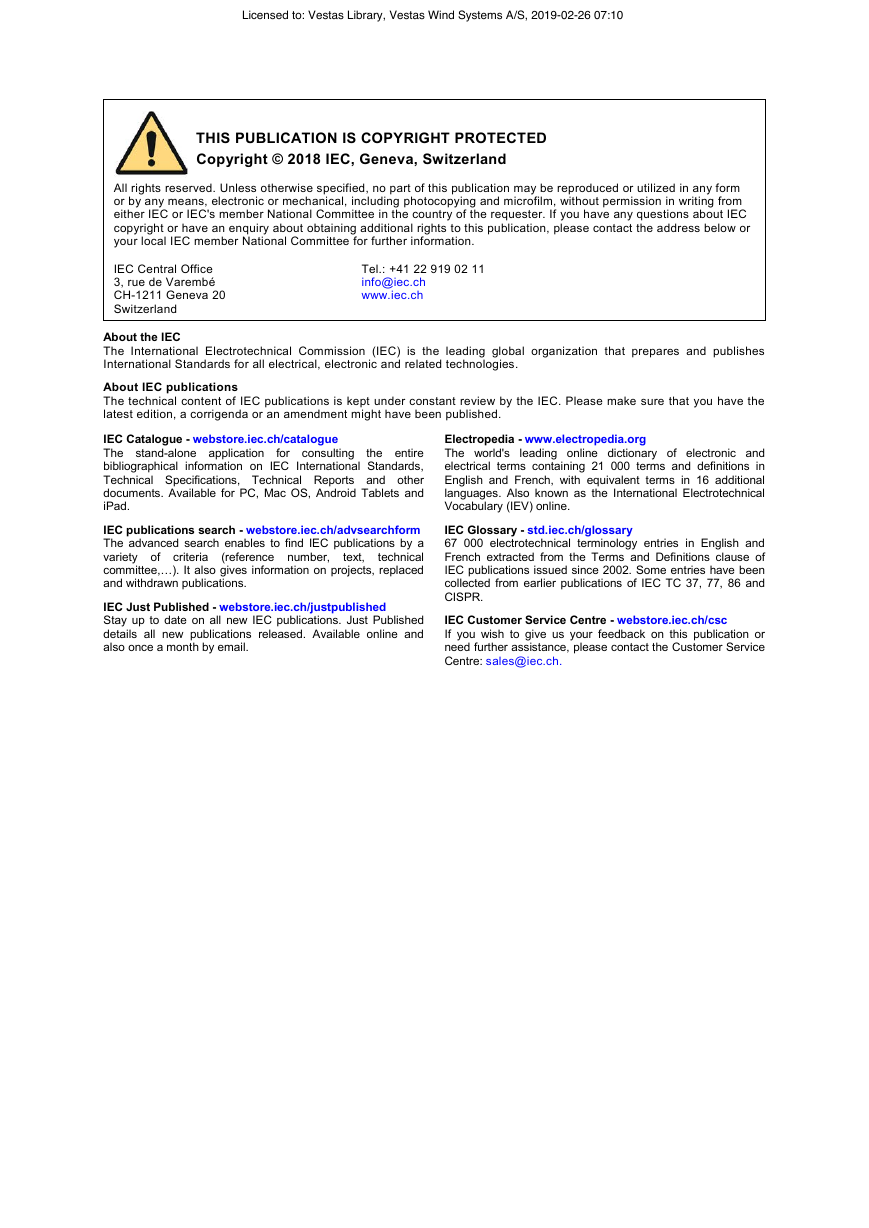
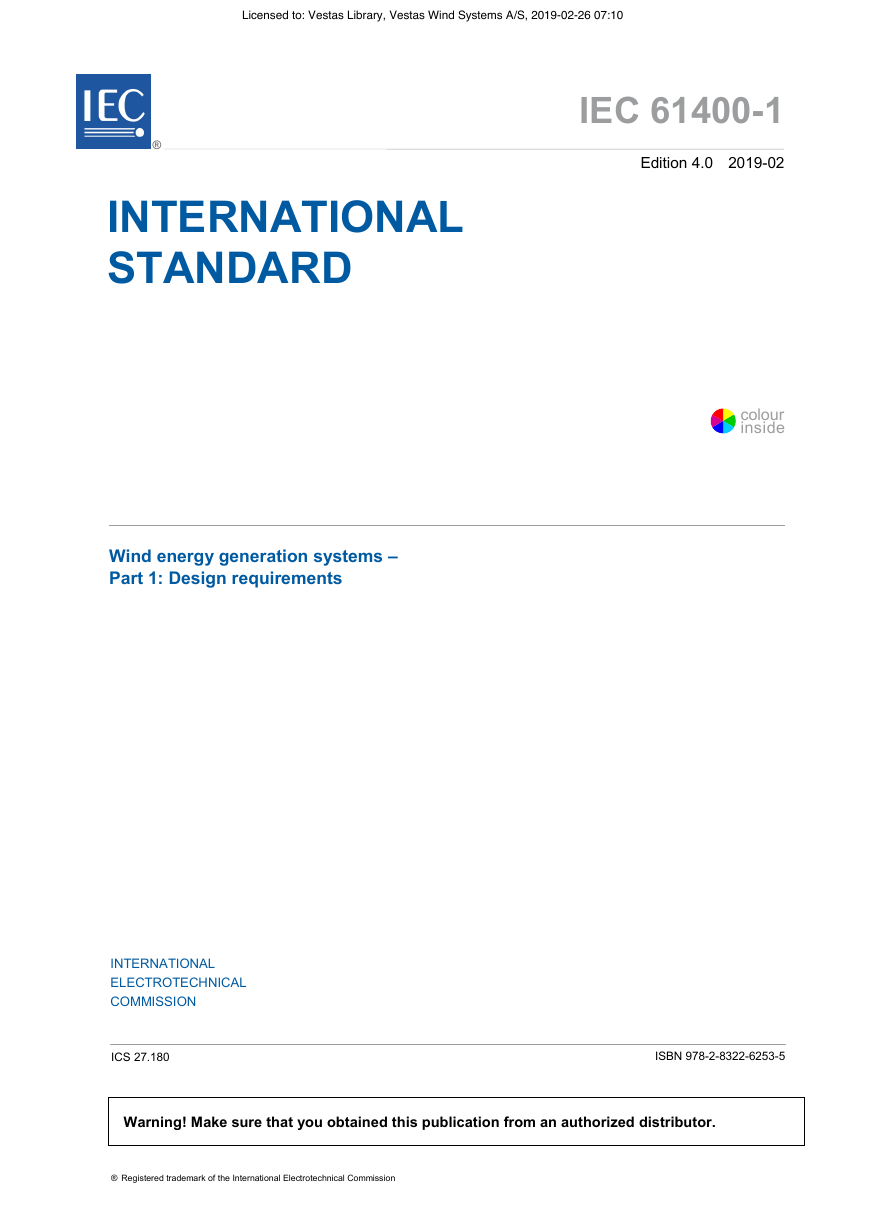
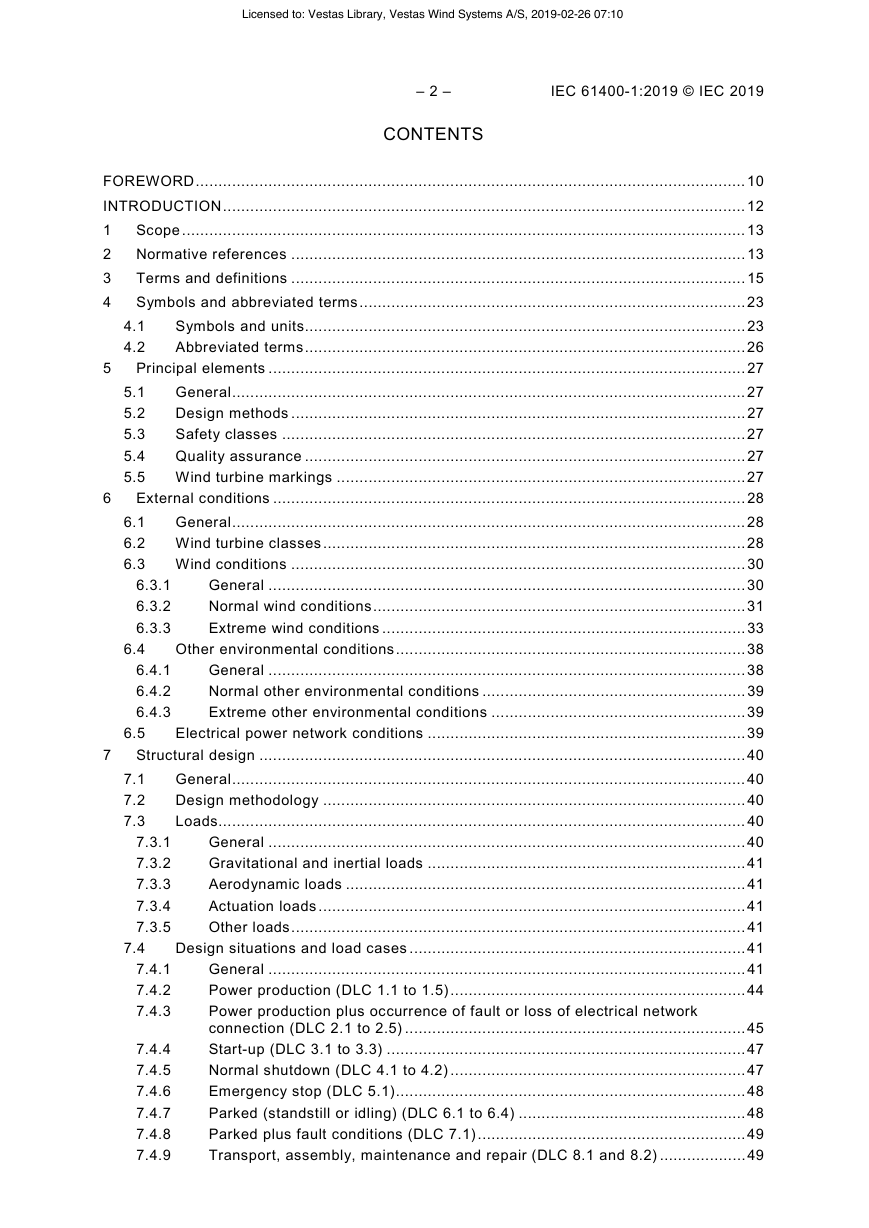
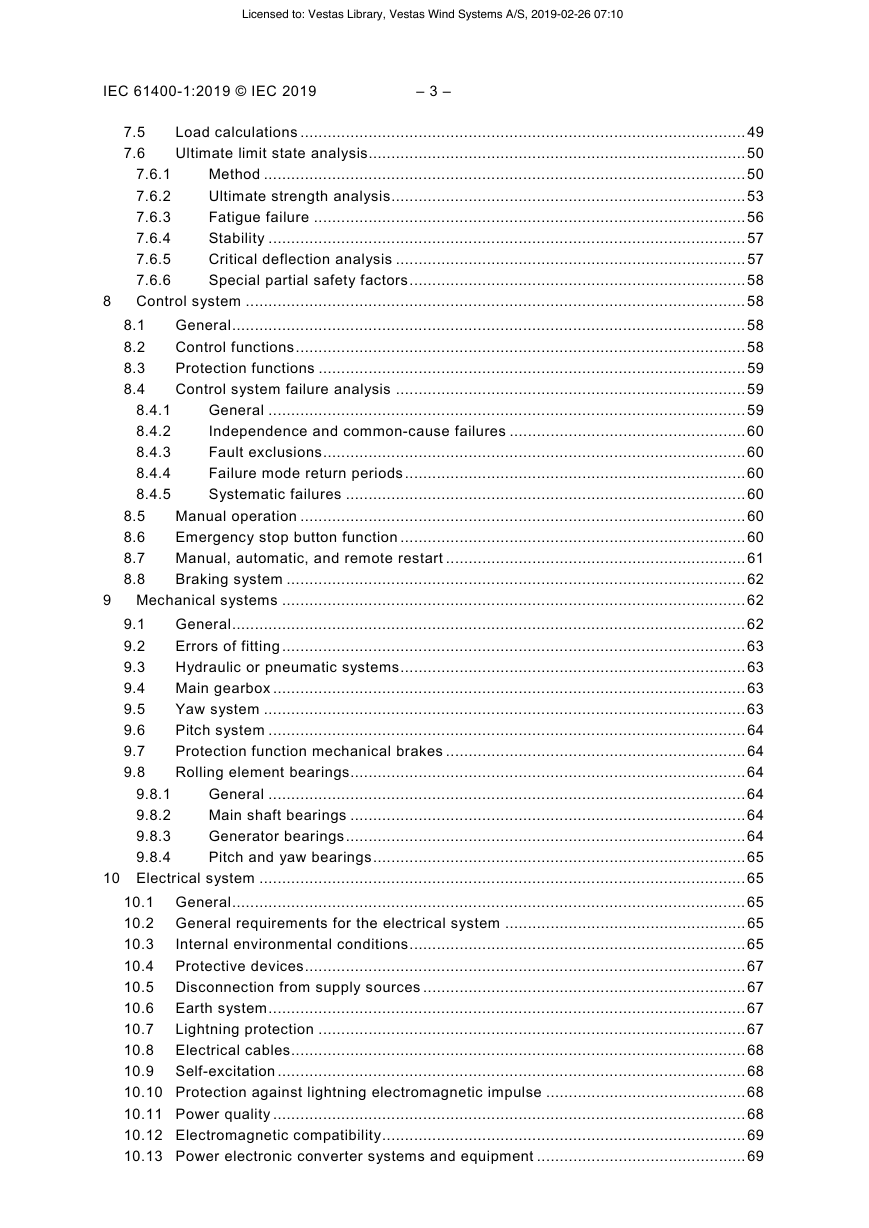
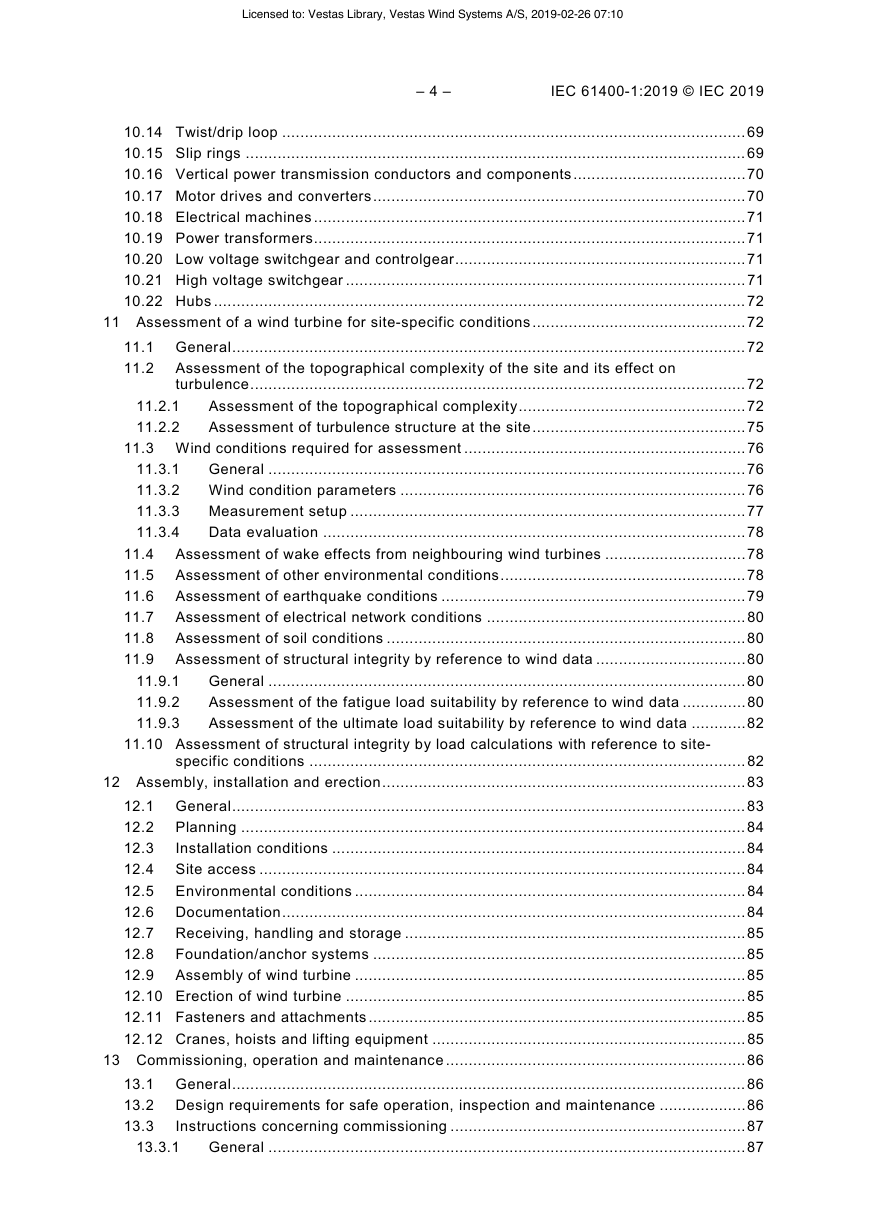










 2023年江西萍乡中考道德与法治真题及答案.doc
2023年江西萍乡中考道德与法治真题及答案.doc 2012年重庆南川中考生物真题及答案.doc
2012年重庆南川中考生物真题及答案.doc 2013年江西师范大学地理学综合及文艺理论基础考研真题.doc
2013年江西师范大学地理学综合及文艺理论基础考研真题.doc 2020年四川甘孜小升初语文真题及答案I卷.doc
2020年四川甘孜小升初语文真题及答案I卷.doc 2020年注册岩土工程师专业基础考试真题及答案.doc
2020年注册岩土工程师专业基础考试真题及答案.doc 2023-2024学年福建省厦门市九年级上学期数学月考试题及答案.doc
2023-2024学年福建省厦门市九年级上学期数学月考试题及答案.doc 2021-2022学年辽宁省沈阳市大东区九年级上学期语文期末试题及答案.doc
2021-2022学年辽宁省沈阳市大东区九年级上学期语文期末试题及答案.doc 2022-2023学年北京东城区初三第一学期物理期末试卷及答案.doc
2022-2023学年北京东城区初三第一学期物理期末试卷及答案.doc 2018上半年江西教师资格初中地理学科知识与教学能力真题及答案.doc
2018上半年江西教师资格初中地理学科知识与教学能力真题及答案.doc 2012年河北国家公务员申论考试真题及答案-省级.doc
2012年河北国家公务员申论考试真题及答案-省级.doc 2020-2021学年江苏省扬州市江都区邵樊片九年级上学期数学第一次质量检测试题及答案.doc
2020-2021学年江苏省扬州市江都区邵樊片九年级上学期数学第一次质量检测试题及答案.doc 2022下半年黑龙江教师资格证中学综合素质真题及答案.doc
2022下半年黑龙江教师资格证中学综合素质真题及答案.doc